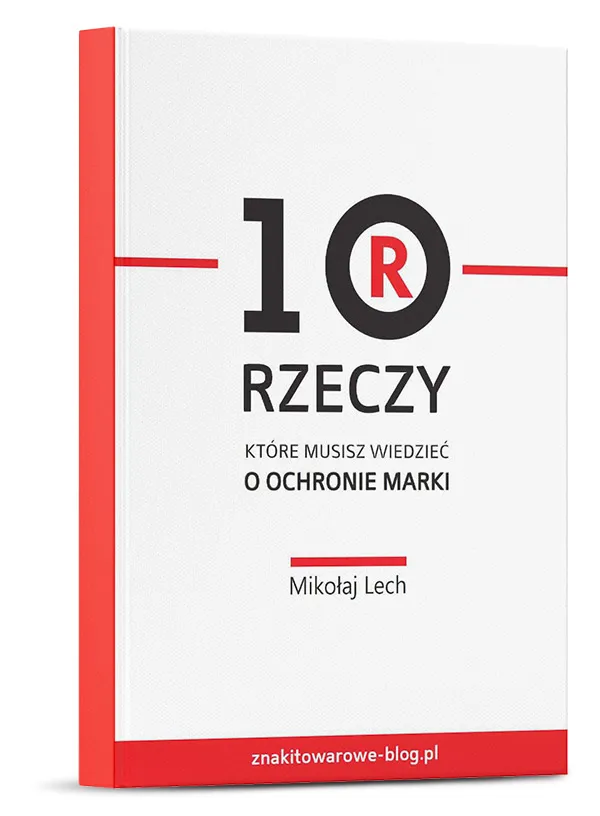- Check 👉 the prices for my services
Spis treści
- • Registration of a trademark – a new procedure in Poland
- • What are these revolutionary changes about?
- • How did you check if your company name is available?
- • A huge mess among the company names
- • What does the trademark searching and Brand Analysis look like?
- • Be careful not to inform your competition about yourself!
- • Trademark registrability search and Brand Analysis by a professional
- • 1. Help in preparing a good list of goods and services
- • 2. Help in avoiding lawsuit over violation of the right
- • 3. Help in circumventing a competitive trademark
- • 4. Help in protecting other valuable company components
- • Order a trademark registrability search and Brand Analysis to a trademark attorney
Registration of a trademark – a new procedure in Poland
Registration of a trademark can lasts in Poland about 6 months.
See also:
- Registering logo as an industrial design. The pros and cons of such a strategy.
Do you think it’s a lot?
In the 90s it lasted… 5 years!
It resulted from the staff problems of the Patent Office. New companies then appeared like mushrooms after the rain, and the number of experts examining applications was insufficient. This greatly extended the whole proceeding.
In this context, the current 6 months is a very good result 🙂
In Poland, there was a major change in the registration of a trademark system in 2016. In place of the previous procedure, we now have the so-called opposition procedure.
What are these revolutionary changes about?
After you file an application, the owners of earlier similar trademarks have 3 months to file an opposition to registration. To prevent this from happening, you should do a trademark searching and Brand Analysis beforehand.
It is important because even if a competitor overlooks this period to file an opposition, he has 5 years to submit an application for a declaration of invalidity of your trademark.
Therefore, the problem may be postponed.
How did you check if your company name is available?
I noticed that most people only do a superficial legal analysis of the brand.
First they enter the chosen name in the Google search engine.

If they do not find competing companies there, they are still checking whether an Internet domain is available. And most often all trademark searching ends there. However, such trademark searching and Brand Analysis is far from sufficient.
First of all, Google currently shows local results first.
There is a small chance that you will easily get information about, for example, a Spanish competitor with the same name. Meanwhile, if such a company has made a registration of a trademark within the European Union territory, it has a kind of legal monopoly also in Poland.
And even when it never operated in Poland.
Also note that the same company may not feel the need to buy every
national domain that contains their trademark. The more that if
necessary, based on the rights to its EU mark, it can take your domain by force.
A huge mess among the company names
Entrepreneurs are mistakenly convinced that they can use the given name because the clerk did not cause them a problem when registering the company.
This is just a myth, because no clerk will do you a check to see if your company name breaks the law.
The clerk’s work is often limited to stamping the document.
The effect of this is that in National Register I found almost 400 companies called TOMBUD and almost 600 called ART-BUD. I’m sure most of these people think they have exclusive rights to their company name.
The consequence of this situation is that I get entrepreneurs who unknowingly violated other people’s rights. They simply chose names that are similar to those already registered trademarks.
These are always very hard conversations. Of course, every time I am looking for a way to get the customer out of trouble. Unfortunately, in some situations there is no other way than to change the name.
For people who have put a lot of time, money and heart into developing their brand, it’s a real drama. This can probably only be compared to having to change your name after years of building a good opinion.
What does the trademark searching and Brand Analysis look like?
The trademark searching and Brand Analysis consists of several stages.
Stage 1
First, I check whether the name chosen by the entrepreneur can be a trademark at all. The point is that the regulations list certain categories of signs that are excluded from registration.
For example, you will not register a descriptive sign, i.e. one that clearly indicates a product or service that you offer. An expert from the Patent Office will refuse to register the word „bread” for bread. And although this example I think is obvious to you, the owners of online shops very often choose descriptive names.
It is easy to guess what is offered under the domain:
- dishes24.com or
- E-perfume.
Stage 2
Remember that:
It does not matter if you think that the trademarks are similar.
It is only important how your case will be evaluated by the Patent Office or in case of the dispute, an appropriate court.
Here I am looking for similar trademarks with an earlier registration date.
This is important because the collision are not only identical trademarks. The similarity is assessed first for similar goods and services, and then for the names themselves.
To draw the right conclusions you need to have extensive knowledge and experience with trademarks.
The point is that all the conflict rules for the trademarks have been formulated over the years by the courts. Knowing these rulings, I can predict if the expert will consider the compared marks as similar or not.
For example, the trademarks considered similar:

COSIMO vs COSIFLOR
Alia vs Malia
LINDENER vs LINDEBOOM
Nado vs Yonado
Lubelska vs Lubeca
On the other hand, similarities were not found in these cases:
STILO vs STIHL
NEXON vs NEXANS
IBUVIT vs IBUM
PLATINUM MEN vs PLATINÉUM
OVT vs OVG
With these real examples from the market I wanted to show you that the assessment of collision of signs is not as simple as it may seem.
Stage 3
At the last stage, I formulate conclusions and recommendations for clients. Besides indicating the trademarks that are the greatest threats, I always show possible ways out.
I often compare it to a ship that affects a minefield.
If the captain knows where the mines are, he can maneuver the ship so that he can safely swim past them. I try to advise my client to finally register his mark. And there are really many ways to do this.
Be careful not to inform your competition about yourself!
Did you know that by filing for registration of a trademark you can cause problems? It turns out that EUIPO, the EU trademark registration office, will notify about your application the similar trademark owners with prior registration.
Later, he will wait 3 months for any of them to file an opposition.
Customer History:
An entrepreneur who once received a sharp warning letter from a large British law firm contacted with me. They demanded from him not only to withdraw the trademark he had just filed, but also to leave his goods on the Polish market within 14 days.
It turned out that the mark applied for was very similar to their client’s EU trade mark. The whole confusion would not have happened if my client had done a trademark searching and Brand Analysis before. Knowing about the existence of such a mark, I would advise him against filing of an application.
The British law firm found out of his existence just from information from EUIPO.
Trademark registrability search and Brand Analysis by a professional
A good time to research is when the brand is not yet on the market. Although it’s better to think about it before you order a logo or website.
Remember that a good company name should satisfy both the marketer and the trademark attorney. On the one hand, the brand should be simple and memorable, and on the other it should be possible to register it.
You can try to do a trademark registrability search and Brand Analysis by yourself. However, with the help of a trademark attorney, you will avoid mistakes.
I will show you the advantages of this option using examples from my professional work.
1. Help in preparing a good list of goods and services
When doing a trademark registrability search and Brand Analysis, I start by consulting what goods and services we should check and later enter in the application. This is important because you will not be able to add anything to the list after the application will be filled.
One of my clients ran a restaurant. I advised him that beside restaurant services he should include also catering services. Many companies from his branch do this. And what if it comes into such services in the future. In addition, it will not even affect the higher fees, because these services are in the same class.
5 years have passed since then. On this occasion, the client with undisguised joy told me that currently 80% of income is derived from dietetic catering.
2. Help in avoiding lawsuit over violation of the right
If as a result of the trademark registrability search and Brand Analysis I catch a collision, then the client has time to quietly get off the name.
I used to do a trademark registrability search and Brand Analysis for a jeweler who had been working for 10 years under the chosen name. When his son joined the business, he came to me to secure the company’s brand. Unfortunately, I located his competitor, who had been protecting a phonetically identical mark in Poland for 15 years. The effect of this was that we found another safe name for him, thanks to which he rebranded.
The competitor never found out about the infringement.
3. Help in circumventing a competitive trademark
If I see a threat in a trademark, I indicate what changes the client should make in his trademark to bypass the collision. This is important because a competitor could apply to him after several years with serious claims.
All these modifications are made so that in the event of a dispute I can build a defense line based on the fact that the trademarks differ so that there is no danger of misleading anyone.
In other words – knowing on the basis of what accusations a competitor can attack us, I will suggest such changes that will minimize the risk of violation of the law.
4. Help in protecting other valuable company components
When I discuss the results of a trademark registrability search and Brand Analysis with a client, I point out how to repair negligence regarding other significant assets of the company.
It regards, among others to:
- preparing an agreement for the transfer of copyright to the logo;
- preparation of confidentiality agreement for employees;
- preparing a non-competition agreement;
- determining if the company’s domain is registered on whom;
- protection of leading products.
And that you would also understand me well.
After a trademark registrability search and Brand Analysis is done, you always receive important information:
- In the positive variant, you find out that there is no collision, so you can go ahead and file your trademark for protection.
- In the negative option, you learn that the chances of registration of the mark are small. On the other hand, without entering the market with such a brand, you avoid costly litigation in court. And that means saving nerves and money.
You will probably agree with me that business needs peace and security.
Did you know that:
Trademarks filed with the help of an experienced representative are 50% more frequently registered than trademarks registered by yourself.
Trademark lawyers are not necessary for the successful completion of the entire proceedings, but significantly increase the likelihood of success.
These are the conclusions of the Stanford Technology Law Review from 2013 in which all trademarks filed in the USA in 1985-2010 were analyzed.
Order a trademark registrability search and Brand Analysis to a trademark attorney
Of course, you don’t have to get the help of a trademark attorney. Moreover. There is no obligation to do such a trademark registrability search and Brand Analysis at all.
To be honest, however, trademark registrability search and Brand Analysis is a safe option for you.
You do not file the mark in the dark hoping that the Patent Office will not create problems for you.
A trademark registrability search and Brand Analysis locates obstacles to registration more often than you think.
When I do a trademark registrability search and Brand Analysis on:
- Poland – the collision is in 1 in 3 cases;
- EU – collision is in 1 in 2 cases (!).
Recently, I began to wonder if I am doing more and more detailed trademark registrability search and Brand Analysis, or whether it has become tighter on the market.
If you want, I can also do the trademark registrability search and Brand Analysis for you.
Just contact me.
Zobacz również:
- Jak odzyskać domenę internetową? Szantaż domenowy.
- Jakie są rodzaje znaków towarowych?
- Wymyśliłem nazwę firmy. Czy mam do niej prawa autorskie?
- Jak chronić nazwę firmy? 5 mitów, które mogą zniszczyć Twoją firmę!
- Czy trolle od znaków towarowych działają w Polsce?
- Program Współpraca w Ochronie Praw a podróbki na Allegro
- Jak sprawdzić czy logo nie jest plagiatem
- Co oznacza symbol TM przy logo?
FAQ
My name differs by 30% from my competitor’s name. Is it safe?
It’s much more complicated than that. There is no statutory amount of differences that provide safety. This is assessed on a case-by-case basis.
🔴 Example of a collision. The signs „LIQUOR STORE FENIX” and „MARKET FENIKS” will be considered similar. Although 80% of the letters are different, customers will associate both stores with the name Fenix. Its wording is irrelevant.
🟢 Example of no collision. „CLINIC ONKOMEDIKA” and „POLYCLINIC ONKOMEDIKA”. Cancer patients will immediately recognize that this is a place where this type of disease is treated. It is therefore a descriptive term that anyone can use.
A legal analysis of a brand is a time-consuming and highly responsible process. A mistake at this stage can result in having to change the company name after a few months. Therefore, it’s worth 👉ordering a patent attorney to carry out this verification.
What names cannot be registered at the Patent Office?
There are specific types of names that an expert reviewing an application may reject. Statistics show that this happens in 28% of cases, resulting in the loss of all fees paid for the application.
The most common reason for rejection of registration is that your name is:
🔴 Descriptive. This refers to terms that are too common and popular in your industry. For example, „alkohole24” or „VIP MEBLE”.
🔴 Generic. There are names that have entered into everyday language. „Great tattoo” means a tattoo parlor and „Strong cup of coffee” is colloquially used for coffee.
🔴 Non-distinctive. This is a name that does not indicate a specific product or service, but is still a free term, e.g. OCCASIONS.PL.
NOTE: You can be refused even if you are the only one using a certain name. What matters to the expert is how buyers will perceive it. One solution may be to apply for registration not for the name, but for a logo🟢. I explain this in detail here: 4 strategies for legal brand protection.


 Mikołaj Lech
rzecznik patentowy
Mikołaj Lech
rzecznik patentowy






